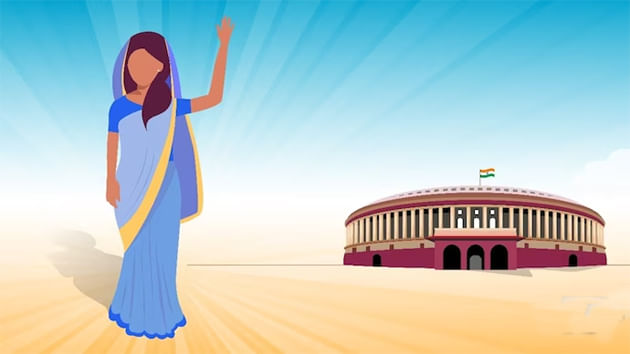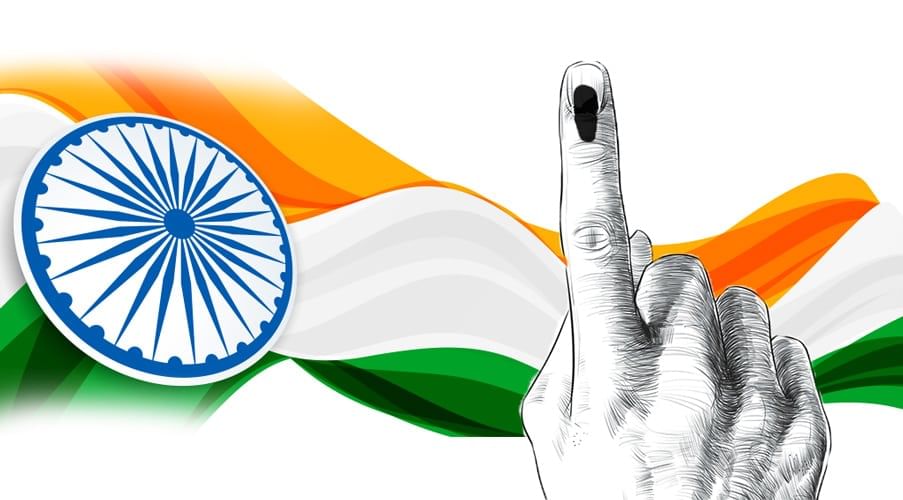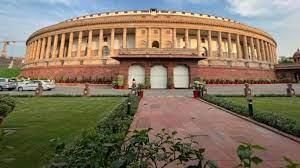Indian Polity and Governance - 3 | Current Affairs & Hindu Analysis: Daily, Weekly & Monthly - UPSC PDF Download
| Table of contents |

|
| Nari Shakti Vandan [constitution (106th Amendment)] Act, 2023 |

|
| Simultaneous Elections |

|
| Artificial Intelligence and Election |

|
| Personality Rights |

|
| Secretariat of The Parliament |

|
Nari Shakti Vandan [constitution (106th Amendment)] Act, 2023
In September 2023, Parliament approved the Constitution (106th Amendment) Act, 2023, providing for a one-third reservation for women in the Lok Sabha, State Assemblies, and the National Capital Territory (NCT) of Delhi.
Historical Background of Women’s Reservation
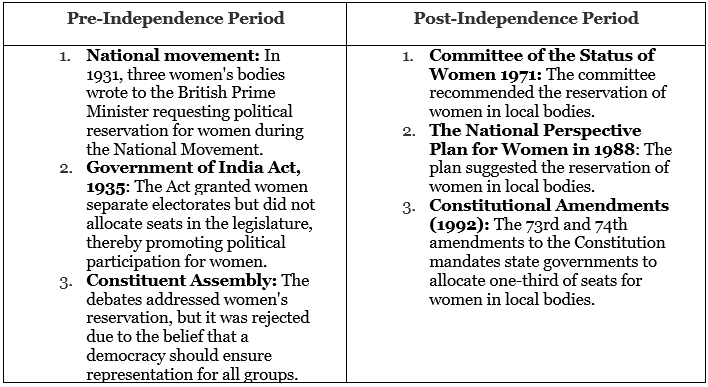
Background of the bill
- The Constitution has been amended several times to allocate seats for women in Parliament and state legislative assemblies.
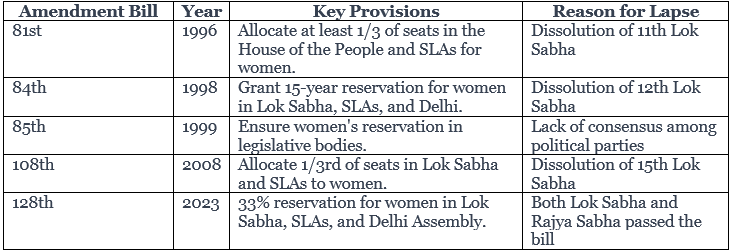
Key changes between 2008 and 2023 Bills

Key Features of the 2023 Act
Reservation for Women in the Lower House (Lok Sabha):
- The Act introduces Article 330A to the constitution, assimilating elements from Article 330, which allocates seats to SCs/STs in the Lok Sabha.
- It permits the rotational allocation of reserved seats for women across different states or Union Territories.
- The primary objective is to distribute one-third of the seats reserved for SCs/STs to women in a rotating manner.
Reservation for Women in State Legislative Assemblies:
- The Act introduces Article 332A, mandating the reservation of seats for women in every State Legislative Assembly.
- One-third of the seats earmarked for SCs and STs are to be reserved for women.
- Additionally, one-third of the seats allotted to women in direct elections to Legislative Assemblies will also be earmarked for them.
Reservation for Women in NCT of Delhi (New clause in 239AA):
- The Act incorporates a new clause, Article 239AA(2)(b), specifying the reservation of one-third of seats for women in the Legislative Assembly of the National Capital Territory (NCT) of Delhi.
- Article 239AA of the constitution accords special status to the Union Territory of Delhi as the national capital concerning administrative and legislative functions.
Commencement of Reservation (New article - 334A):
- The Act includes Article 334 of the constitution, which compels parliament to reassess reservation provisions after 70 years of the law's enactment.
- The provisions of this act will come into effect post delimitation and the initial census following the commencement of this act.
- A 15-year sunset clause for the parliamentary review of reservation provisions for women is introduced, and parliament has the legal authority to extend the reservation.
Rotation of Seats:
- Parliament, through legislation, has the authority to determine the periodic rotation of seats reserved for women after each subsequent delimitation.
- The provisions of this act will not impact the representation in Legislative Assemblies and the Lok Sabha until their dissolution.
Arguments in favor
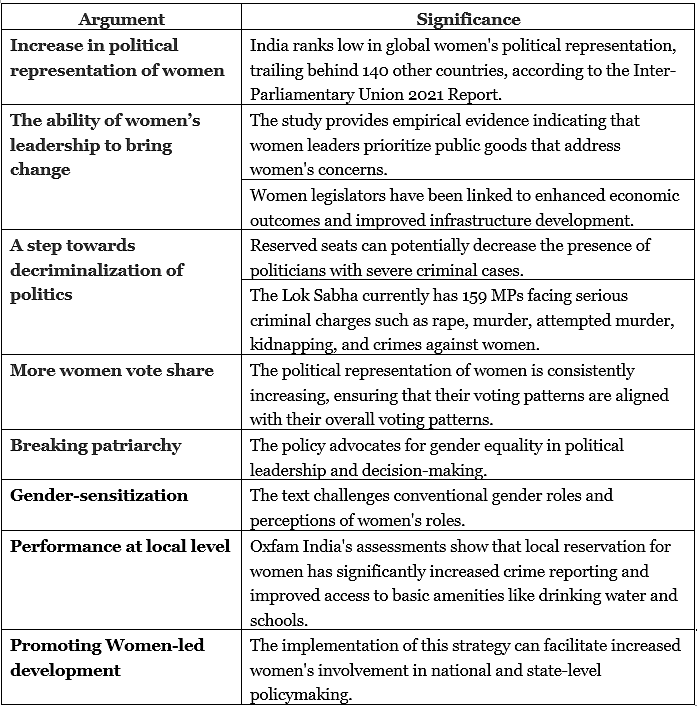
Arguments against the act
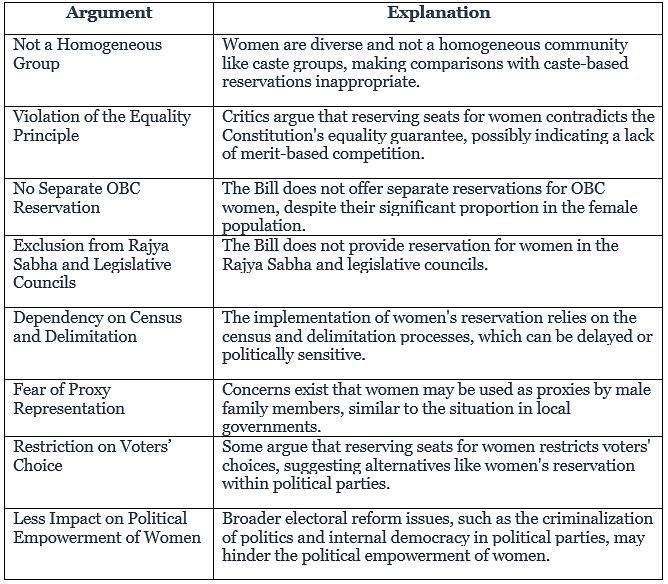
The Way Forward
Ensure Timely Implementation:
- Guarantee the timely implementation of the act by conducting and publishing census data and undertaking the delimitation exercise promptly.
Capacity Building:
- Involve civil society and other institutions in locally-based training and mentorship programs for women leaders, aiming to enhance their effective mobilization at state and national levels.
Raise Awareness and Education:
- Increase awareness about women's rights and underscore the importance of their political participation.
Combat Gender-Based Violence:
- Implement policies and legal measures to combat gender-based violence and harassment, creating a safer political environment for women.
Electoral Reforms:
- Introduce proposed reforms, including implementing electoral changes like proportional representation and preferential voting, to augment the representation of women in the political process.
Intra-Party Democracy:
- Institutionalize intra-party democracy to encourage and promote the candidacy of more women.
Strengthen Women’s Self-Help Groups:
- Encourage the involvement of women at the grassroots level through support for women's self-help groups, preparing them for higher office positions.
Support Women’s Agencies:
- Enhance support for organizations dedicated to promoting gender equality and women's empowerment.
Engage Young Women:
- Promote the involvement of young women in student politics and political debates within colleges and universities.
Conclusion
The reservation is anticipated to significantly contribute to the nation's development, particularly for women, by addressing underlying socio-economic and political disparities. Implementation of the outlined strategies is crucial for the successful realization of these goals.
Simultaneous Elections
A committee, led by former President Ram Nath Kovind, has been established by the Central government to assess the viability of the 'one nation, one election' (ONOE) proposal.
- Although faced with logistical and other obstacles, the concept of conducting Simultaneous Elections/ONOE for both the Lok Sabha (Parliament) and state Assemblies in India has been a subject of ongoing deliberation.
What are Simultaneous Elections?
Overview:
- The concept revolves around aligning the electoral cycles in India to ensure that elections for both the Lok Sabha and State Assemblies occur concurrently within a specified timeframe.
- While this approach was once practiced until 1967, it gradually fell out of favor due to frequent dissolutions of Assemblies and Lok Sabhas before completing their terms.
- Presently, only a few states (Andhra Pradesh, Arunachal Pradesh, Odisha, and Sikkim) hold elections concurrently with the Lok Sabha polls.
Advantages:
- As per the draft report on simultaneous elections by the Law Commission of India (LCI) in August 2018, the 'one nation, one election' (ONOE) initiative would result in cost savings, reduced strain on administrative and security forces, timely implementation of government policies, and administrative focus on development activities instead of electioneering.
What are the Challenges in Holding Simultaneous Elections?
Feasibility:
- Articles 83(2) and 172 of the Indian Constitution stipulate a five-year tenure for Lok Sabha and State Assemblies, subject to earlier dissolution.
- The ONOE plan raises feasibility concerns if the Central or State government collapses mid-tenure. Amending the Constitution for such a change requires extensive consideration and sets a precedent for more constitutional amendments.
Not Aligned with Federalism:
- The ONOE concept contradicts the federal structure as it assumes the entire nation is "one," contrary to the "Union of States" concept in Article 1.
Present Form's Benefits:
- The current periodic elections in a democracy allow voters to express their views more frequently. This framework prevents the blending of national and state issues, ensuring greater accountability.
EVM and VVPAT Requirement:
- Simultaneous elections would necessitate around 30 lakh Electronic Voting Machines (EVMs) and Voter-Verified Paper Audit Trail (VVPAT) machines.
Cost Considerations:
- Simultaneous elections would incur substantial costs, with an estimated Rs 9,284.15 crore required for procuring EVMs and VVPATs. Additional costs include machine replacements every 15 years and increased warehousing costs.
Impact on Voter Behaviour:
- Critics argue that simultaneous elections might influence voter behavior, leading them to prioritize national issues even in State elections, potentially favoring larger national parties and marginalizing regional ones.
Election Issues:
- State and national elections often revolve around different issues, and in simultaneous elections, voters might prioritize one set over the other, impacting the electoral dynamics.
Diminished Accountability:
- Frequent elections enhance the accountability of politicians, keeping them responsive to the electorate. Additionally, elections generate employment opportunities, contributing to grassroots-level economic growth.
How can Simultaneous Elections be Restored in India?
According to the Recommendations of the Law Commission Working Paper (2018),
- Simultaneous elections may be restored through an amendment of the Constitution, Representation of the People Act, 1951 and Rules of Procedure of Lok Sabha and State Legislative Assemblies. A definition may be added to section 2 of the 1951 Act.
- The no-confidence motion may be replaced with a constructive vote of no-confidence through amendments in Lok Sabha and State Assemblies rules of business.
- Anti-Defection Law may be suitably diluted to prevent stalemate in case of a hung Assembly or Parliament
- The statutory limit of six months for issuance of notification of general elections may be extended for securing flexibility as a one-time measure.
What are the Countries where Simultaneous Elections are conducted?
- In South Africa, elections to national as well as provincial legislatures are held simultaneously for five years and municipal elections are held two years later.
- In Sweden elections to the national legislature (Riksdag) and provincial legislature/county council (Landsting) and local bodies/municipal Assemblies (Kommunfullmaktige) are held on a fixed date i.e. second Sunday in September for four years. But most other large democracies do not have any such system of simultaneous elections.
- In Britain, the Fixed-term Parliaments Act, 2011 was passed to provide a sense of stability and predictability to the British Parliament and its tenure. It provided that the first elections would be held on the 7th of May, 2015 and on the first Thursday of May every fifth year thereafter.
- Article 67 of Basic Law for the Federal Republic of Germany proposes a constructive vote of non-confidence (electing a successor while dismissing the incumbent).
Way Forward
- Elections are held at different places every few months and it hampers the developmental work. Therefore, it’s a must to have a deep study and deliberation on the idea in order to prevent the impact of the model code of conduct on development works every few months.
- There needs to be a consensus on whether the country needs one nation, one poll or not. All political parties should at least cooperate in debating this issue, once the debate starts, the public opinion can be taken into consideration. India being a mature democracy, can then follow the outcome of the debate.
Artificial Intelligence and Election
Artificial Intelligence (AI) has captured significant interest, driven by its notable accomplishments and the apprehensions voiced by experts. The Association for Computing Machinery and numerous AI entities stress the significance of responsible algorithmic systems.
- Despite AI's proficiency in specific tasks, it encounters challenges in generalizing knowledge and lacks inherent common sense. The notion of achieving Artificial General Intelligence (AGI) sparks ongoing debates, with some envisioning its feasibility in the future.
AI Systems: Wide Range of Applications
- Healthcare: AI can assist in medical diagnosis, drug discovery, personalized medicine, patient monitoring, and data analysis for disease prevention and management.
- Finance and Banking: AI can be utilized for fraud detection, risk assessment, algorithmic trading, customer service chatbots, and personalized financial recommendations.
- Transportation and Logistics: AI enables autonomous vehicles, route optimization, traffic management, predictive maintenance, and smart transportation systems.
- Education: AI can support personalized learning, intelligent tutoring systems, automated grading, and adaptive educational platforms.
- Customer Service: AI-powered chatbots and virtual assistants improve customer interactions, provide real-time support, and enhance customer experience.
- Natural Language Processing: AI systems excel in speech recognition, machine translation, sentiment analysis, and language generation, enabling more natural human-computer interactions.
- Manufacturing and Automation: AI helps optimize production processes, predictive maintenance, quality control, and robotics automation.
- Agriculture: AI systems aid in crop monitoring, precision agriculture, pest detection, yield prediction, and farm management.
- Cybersecurity: AI can identify and prevent cyber threats, detect anomalies in network behavior, and enhance data security.
- Environmental Management: AI assists in climate modeling, energy optimization, pollution monitoring, and natural disaster prediction.
Some of the primary constraints of AI systems
Absence of Common Sense and Contextual Understanding:
- AI systems face challenges in common sense reasoning and comprehending context beyond their specific training tasks. They may misinterpret ambiguous situations or lack the intuitive judgment capabilities that humans possess.
Data Dependence and Bias:
- AI systems heavily lean on the data used for their training. If the training data is biased or incomplete, it can lead to biased or inaccurate outputs, perpetuating societal biases and raising ethical concerns regarding discrimination against certain groups.
Explanatory Limitations:
- Deep learning models, like neural networks, are often perceived as "black boxes" due to their lack of transparency in decision-making. Understanding the rationale behind AI outputs becomes challenging, especially in critical domains like healthcare and justice, where trust and verifiability are crucial.
Restricted Transfer Learning:
- While excelling in specific tasks, AI systems struggle to apply knowledge to new or unseen domains. Their adaptability and generalization capabilities are limited, often necessitating substantial labeled data for training in each specific domain.
Vulnerability to Adversarial Attacks:
- AI systems are susceptible to adversarial attacks, where input data is manipulated to induce incorrect or malicious decisions. This vulnerability poses security risks in applications like autonomous vehicles or cybersecurity.
Ethical and Legal Considerations:
- The deployment of AI systems raises ethical and legal concerns, including privacy violations, accountability for AI-driven decisions, and potential impacts on human employment. Balancing technological advancements with ethical and societal considerations presents a significant challenge.
Computational Resource Requirements:
- Training and operating complex AI models demand substantial computational resources, involving high-performance hardware and extensive data storage. This poses challenges to the accessibility and affordability of AI technology, particularly in resource-constrained environments.
What is Artificial General Intelligence (AGI)?
- AGI is a hypothetical concept of AI systems that possess the ability to understand, learn, and apply knowledge across a wide range of tasks and domains, similar to human intelligence.
- Unlike narrow AI systems, which are designed to excel at specific tasks, AGI aims to achieve a level of intelligence that surpasses human capabilities and encompasses general reasoning, common sense, and adaptability.
- The development of AGI is considered a significant milestone in AI research, as it represents a leap beyond the limitations of current AI systems.
Concerns and Dangers Associated with the Development and Deployment of AI systems
- Superhuman AI: One concern is the possibility of highly intelligent AI systems surpassing human capabilities and becoming difficult to control. The fear is that such AI systems could lead to unintended consequences or even pose a threat to humanity if they were to act against human interests.
- Malicious Use of AI: AI tools can be misused by individuals with malicious intent. This includes the creation and dissemination of fake news, deepfakes, and cyberattacks. AI-powered tools can amplify the spread of misinformation, manipulate public opinion, and pose threats to cybersecurity.
- Biases and Discrimination: AI systems are trained on data, and if the training data is biased, it can lead to biased outcomes. AI algorithms can unintentionally perpetuate and amplify societal biases, leading to discrimination against certain groups. This bias can manifest in areas such as hiring practices, criminal justice systems, and access to services.
- Lack of Explainability and Transparency: Deep learning models, such as neural networks, often lack interpretability, making it difficult to understand why an AI system arrived at a specific decision or recommendation. This lack of transparency can raise concerns about accountability, trust, and the potential for bias or errors in critical applications like healthcare and finance.
- Job Displacement and Economic Impact: The increasing automation brought about by AI technologies raises concerns about job displacement and the impact on the workforce. Some jobs may be fully automated, potentially leading to unemployment and societal disruptions. Ensuring a smooth transition and creating new job opportunities in the AI-driven economy is a significant challenge.
- Security and Privacy: AI systems can have access to vast amounts of personal data, raising concerns about privacy breaches and unauthorized use of sensitive information. The potential for AI systems to be exploited for surveillance or to bypass security measures poses risks to individuals and organizations.
- Ethical Considerations: As AI systems become more advanced, questions arise regarding the ethical implications of their actions. This includes issues like the responsibility for AI-driven decisions, the potential for AI systems to infringe upon human rights, and the alignment of AI systems with societal values.
The Importance of Public Oversight and Regulation
- Ethical and Moral Considerations: AI systems can have significant impacts on individuals and society at large. Public oversight ensures that ethical considerations, such as fairness, transparency, and accountability, are taken into account during AI system development and deployment.
- Protection against Bias and Discrimination: Public oversight helps mitigate the risk of biases and discrimination in AI systems. Regulations can mandate fairness and non-discrimination, ensuring that AI systems are designed to avoid amplifying or perpetuating existing societal biases.
- Privacy Protection: AI systems often handle vast amounts of personal data. Public oversight and regulations ensure that appropriate safeguards are in place to protect individuals’ privacy rights and prevent unauthorized access, use, or abuse of personal information.
- Safety and Security: AI systems, particularly those used in critical domains such as healthcare, transportation, and finance, must meet safety standards to prevent harm to individuals or infrastructure. Public oversight ensures that AI systems undergo rigorous testing, verification, and certification processes to ensure their safety and security.
- Transparency and Explainability: Public oversight encourages regulations that require AI systems to be transparent and explainable. This enables users and stakeholders to understand how AI systems make decisions, enhances trust, and allows for the detection and mitigation of errors, biases, or malicious behavior.
- Accountability and Liability: Public oversight ensures that clear frameworks are in place to determine accountability and liability for AI system failures or harm caused by AI systems. This helps establish legal recourse and ensures that developers, manufacturers, and deployers of AI systems are accountable for their actions.
- Social and Economic Impacts: Public oversight and regulation can address potential negative social and economic impacts of AI, such as job displacement or economic inequalities. Regulations can promote responsible deployment practices, skill development, and the creation of new job opportunities to ensure a just and inclusive transition to an AI-driven economy.
- International Cooperation and Standards: Public oversight and regulation facilitate international cooperation and the establishment of harmonized standards for AI development and deployment. This promotes consistency, interoperability, and the prevention of global AI-related risks, such as cyber threats or misuse of AI technologies.
The Path Forward: Equipping India for AI Progress
Awareness and Education:
- Increase awareness about AI among policymakers, industry leaders, and the public. Promote educational programs focusing on AI-related fields to build a skilled workforce capable of driving AI innovations.
Research and Development:
- Foster research and development in AI technologies by providing funding to academic institutions, research organizations, and startups. Encourage collaborations between academia, industry, and government for AI innovation.
Regulatory Framework:
- Establish a comprehensive regulatory framework that balances innovation with responsible AI development. Develop guidelines and standards addressing ethical considerations, privacy protection, transparency, accountability, and fairness in AI systems. Engage in international discussions on AI governance and regulation.
Indigenous AI Solutions:
- Promote the development of indigenous AI solutions tailored to India’s specific needs. Support startups and innovation ecosystems focused on AI applications in sectors like agriculture, healthcare, education, governance, and transportation.
Data Governance:
- Formulate policies and regulations for responsible data governance. Establish mechanisms for data protection, privacy, and informed consent while facilitating secure data sharing for AI research and development.
Collaboration and Partnerships:
- Foster collaborations between academia, industry, and government to drive AI research, development, and deployment. Encourage public-private partnerships for implementing AI solutions in sectors such as healthcare, agriculture, and governance.
Ethical Considerations:
- Promote discussions and awareness about the ethical implications of AI. Develop ethical guidelines addressing bias, fairness, accountability, and societal impact. Ensure AI systems align with India’s cultural values and societal goals.
Infrastructure and Connectivity:
- Improve infrastructure and connectivity to support AI applications. Enhance access to high-speed internet, computing resources, and cloud infrastructure, facilitating AI deployment nationwide, including rural and remote areas.
Collaboration with International Partners:
- Collaborate with international partners in AI research, development, and policy exchange. Engage in global initiatives to shape AI standards, best practices, and regulations.
Continuous Monitoring and Evaluation:
- Regularly monitor the implementation and impact of AI systems in various sectors. Conduct evaluations to identify risks, address challenges, and make necessary adjustments, ensuring responsible and effective AI use.
Conclusion
The journey toward Artificial General Intelligence (AGI) remains uncertain, but the real risks of malicious AI use and inadvertent harm from biased systems necessitate a balanced approach between innovation and regulation. India should actively participate in discussions, establish a framework safeguarding societal interests, and harness AI's potential for development responsibly.
Personality Rights
Recent Development: The Delhi High Court has recently granted requests for the protection of personality rights to prevent potential misuse by third parties.
Understanding Personality Rights
- Distinctive elements such as the name, voice, signature, images, or any easily recognizable feature of a public figure collectively constitute "personality rights." These may encompass a specific pose, mannerism, or other aspects of their personality.
- Several celebrities go a step further by registering certain elements as trademarks, allowing for commercial use. For instance, Usain Bolt's iconic "bolting" or lightning pose is a registered trademark.
- The underlying principle is that only the owner or creator of these distinctive features has the exclusive right to derive commercial benefits from them.
- Exclusivity plays a crucial role in generating commercial returns for celebrities. Unauthorized use of these elements can lead to a tangible loss of revenue.
- When an unauthorized third party exploits a celebrity's personality rights for commercial gain, the celebrity has the option to approach the Court and seek a prohibitory order.
Trademark Defined:
- A trademark is a recognizable sign capable of distinguishing the goods or services of one enterprise from those of others. Trademarks enjoy protection under intellectual property rights.
- Individuals, business organizations, or legal entities can acquire trademarks.
- In India, regulations governing the registration of trademarks are outlined in The Trade Marks Act of 1999, The Trade Marks Rules of 2002, and The Trade Marks (Amendment) Rules of 2017.
Are personality rights different from publicity rights?
- Personality rights are different from publicity rights.Personality rights consist of two types of rights:
- The right of publicity: The right to keep one’s image and likeness from being commercially exploited without permission or contractual compensation, which is similar (but not identical) to the use of a trademark.
- The right to privacy: The right to not have one’s personality represented publicly without permission.
- Publicity rights are governed by statutes like the Trade marks Act 1999 and the Copyright Act 1957.
How does the law protect personality rights?
- Personality rights and their safeguarding are not explicitly stipulated in Indian statutes but are inferred to be encompassed within the right to privacy and the right to property.
- Numerous intellectual property concepts employed in trademark protection, such as passing off and deception, can be invoked when determining whether a celebrity merits protection through an injunction.
- Ex-parte Injunction: This involves granting relief to one party without affording an opportunity for the other party to present their case.
- Omnibus Injunction: This type of injunction is issued against any unauthorized usage, even those not specifically mentioned in the initial plea.
Secretariat of The Parliament
As India's Parliament commemorates its 75-year journey, it is essential to recognize the pivotal role undertaken by the Parliament secretariat.
- Serving as the backbone of Parliament, the secretariat plays a crucial role in advising presiding officers, furnishing information to Members of Parliament, and ensuring the seamless functioning of legislative processes.
About Parliament Secretariat
- The autonomous secretariat, functioning tirelessly in the background, serves as the backbone of Parliament, providing essential support to legislative functions.
- Each house of Parliament has its own distinct secretarial staff, with recruitment and service conditions regulated by Parliament itself.
- Heading the secretariat of each house is a permanent officer known as the Secretary-General, as specified by Article 98 of the Constitution of India.
Vithalbhai Patel's Role in Establishing the Parliament Secretariat
- Advocacy for Legislative Independence: In 1925, Vithalbhai Patel, the inaugural elected Speaker of the Central Assembly, championed the need for a separate legislative secretariat to ensure independence, complete with direct control over its staff.
- Promotion of Legislative Security: Patel also advocated for the establishment of a dedicated security apparatus for the legislature, emphasizing that the Speaker held authority over the Assembly precincts.
- Standoff Post-Central Assembly Bombing: Following the bombing incident by Bhagat Singh and Batukeshwar Dutt in 1929, the British administration sought to deploy police officers to control access to the Parliament building. Patel vehemently opposed this move, asserting that it encroached upon the Speaker's authority.
- Establishment of Legislative Autonomy: Patel's unwavering efforts led to the creation of a distinct legislative office in 1929, independent of the government.
- Emergence of Specialized Parliament Staff: This period witnessed the development of specialized Parliament staff, laying the groundwork for robust democratic institutions in India. Patel's endeavors played a pivotal role in securing legislative autonomy.
The Role of Parliamentary Reporters
- Parliamentary reporters are individuals responsible for accurately reporting legislative proceedings. They play a vital role in ensuring transparency and accountability in the functioning of parliamentary bodies.
- Their primary task is to document and publish the speeches, statements, and observations made by Members of Parliament (MPs) during parliamentary sittings.
- Parliamentary reporting in India dates back to 1861, driven by the need for accurate reports to counter negative impressions on the native population.
- Over the years, the methods and practices of parliamentary reporting have evolved:
- Early Reports: Initially, reporters produced an "abstract of the observation of members," which provided summaries or synopses of what was said during parliamentary sessions.
- Introduction of Shorthand: With the introduction of shorthand writing, the reporting process became more efficient and accurate. This led to the transition from "abstract of observation" to "abstract of proceedings," as reporters could now capture more detailed information.
- Verbatim Records: By the time the Central Assembly started functioning in 1921, reporters began keeping verbatim records of parliamentary proceedings. This meant that every word spoken by MPs on the House floor was accurately transcribed and documented.
Maheshwar Nath Kaul's Role in Parliament Secretariat
- M.N Kaul, a lawyer by profession, played a pivotal role in professionalizing the Parliament Secretariat and establishing its standard operating procedures.
- His contributions were significant in shaping the Indian parliamentary system and ensuring its smooth functioning.
- Kaul's journey in the world of Indian politics and governance began when he joined the legislative assembly office in 1937.
- Kaul's most significant contributions came during his tenure as the secretary of the Constituent Assembly. In this role, he played a vital part in shaping the constitutional provisions related to legislatures, ensuring that they aligned with the principles of democracy and the parliamentary system.
Post-Independence Contributions
- Assuming Leadership of Lok Sabha Secretariat: Following India's independence, M.N. Kaul took charge of the Lok Sabha Secretariat, persisting in his efforts to fortify parliamentary institutions. Known as the father of the Lok Sabha Secretariat, Kaul played a pivotal role in its development.
- Establishment of Parliament's Research and Reference Service: Acknowledging the necessity of providing comprehensive information to Members of Parliament for informed discussions on bills and other topics, Kaul spearheaded the creation of Parliament's research and reference service—a crucial resource for lawmakers.
- Advocacy for Dedicated Buildings: In 1956, Kaul initiated an ambitious plan to secure separate structures for various parliamentary functions. This encompassed dedicated buildings for the secretariat, library, committee offices, and MPs' offices, showcasing his commitment to modernize and professionalize the Indian parliamentary system.
Evolution of Simultaneous Interpretation Services in Lok Sabha
- Demand for simultaneous interpretation services existed since the inception of Lok Sabha, but a shortage of trained personnel delayed implementation.
- Real-time interpretation in Hindi and English was introduced by the Parliament secretariat in 1964, requiring interpreters with expertise in parliamentary procedures, vocabulary, grammar, language nuances, literature, idioms, and humor.
- Presently, the Parliament secretariat offers simultaneous interpretation in 22 languages to assist Members of Parliament.
Structuring of Parliament Secretariats
- In 1974, a committee of MPs recommended the restructuring of Lok Sabha and Rajya Sabha secretariats into 11 functional areas—a significant milestone in their development.
- Functional areas included legislative, library research and information, verbatim reporting, editorial and translation, interpretation, printing and publication, and watch and ward (later renamed Parliament Security) service.
- Administrative Consolidation: Approximately 2,200 Lok Sabha and 1,500 Rajya Sabha secretariat officers were organized into eight services, streamlining their functions and responsibilities.
- Constitutional Provision: Although the Constitution allows Parliament to regulate the recruitment and conditions of service for secretarial staff, no such law has been enacted. Recruitment and service conditions are determined by rules set by the presiding officers of Lok Sabha and Rajya Sabha.
Role of Secretary General
- The Secretary-Generals in Lok Sabha and Rajya Sabha are appointed by the respective presiding officers, providing them with a certain level of discretion in the selection process.
- For example, the Rajya Sabha recruitment order specifies that the Chairperson of Rajya Sabha shall make the appointment to the post of the Secretary-General.
- Constitutional and Statutory Advisers: Secretary-Generals serve as advisers to the presiding officers of the two Houses, aiding them in fulfilling their constitutional and statutory responsibilities.
- Advising on House Matters: They provide advice on various matters related to the functioning of the House and its committees, ensuring the smooth conduct of parliamentary affairs.
- Administrative Leadership: In their capacity as the head of the respective secretariats, Secretary-Generals oversee the administration of the House and its secretariat.
Lok Sabha Secretariat
- The Speaker of the Lok Sabha advises the Lok Sabha Secretariat, which is an independent entity of the Lok Sabha.
- The Speaker of the Lok Sabha is assisted in the discharge of his constitutional and statutory responsibilities by the Secretary-General, Lok Sabha (whose pay scale, position, and status are equivalent to those of the highest-ranking official in the Government of India, i.e. Cabinet Secretary), Additional Secretary, Joint Secretary, and other officers and staff of the Secretariat at various levels.
- The Secretary General serves until he or she reaches the age of 60, when he or she retires.
- He or she is exclusively accountable to the Speaker, and his or her actions cannot be debated or criticized inside or outside the Lok Sabha.
- In the absence of the Speaker, he summons members of Parliament to a session of Parliament and authenticates bills on behalf of the President of India.
Rajya Sabha Secretariat
- The Rajya Sabha Secretariat was established under the provisions of Article 98 of the Constitution.
- The Chairman of the Rajya Sabha oversees and controls the Rajya Sabha Secretariat.
Functions are
- Providing secretarial assistance and support to the Council of States (Rajya Sabha)
- Providing amenities to Rajya Sabha Members
- Serving the various Parliamentary Committees
- Preparing research and reference material and bringing out various publications
- Recruiting manpower in the Sabha Secretariat and attending to personnel matters
- Preparing and publishing a record of the day-to-day procedure.
|
38 videos|5288 docs|1117 tests
|

